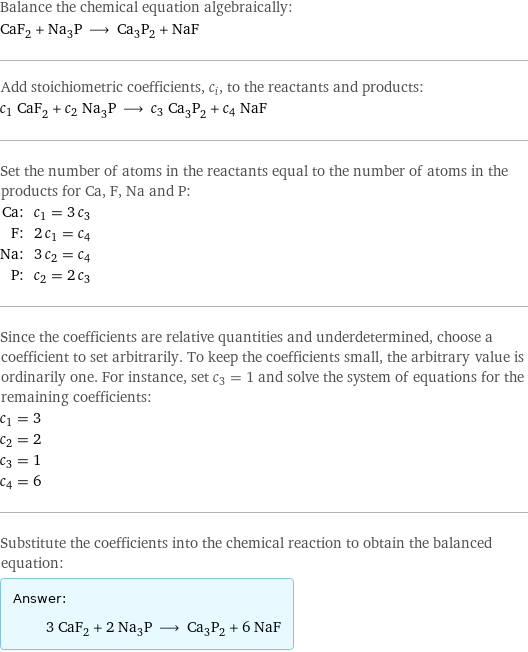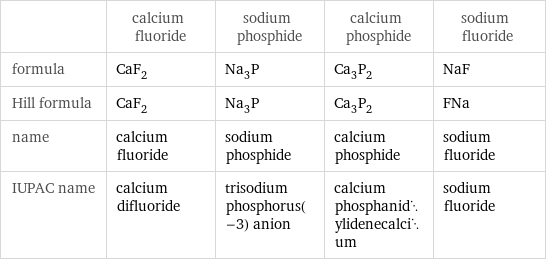Input interpretation

CaF_2 calcium fluoride + Na_3P sodium phosphide ⟶ Ca_3P_2 calcium phosphide + NaF sodium fluoride
Balanced equation

Balance the chemical equation algebraically: CaF_2 + Na_3P ⟶ Ca_3P_2 + NaF Add stoichiometric coefficients, c_i, to the reactants and products: c_1 CaF_2 + c_2 Na_3P ⟶ c_3 Ca_3P_2 + c_4 NaF Set the number of atoms in the reactants equal to the number of atoms in the products for Ca, F, Na and P: Ca: | c_1 = 3 c_3 F: | 2 c_1 = c_4 Na: | 3 c_2 = c_4 P: | c_2 = 2 c_3 Since the coefficients are relative quantities and underdetermined, choose a coefficient to set arbitrarily. To keep the coefficients small, the arbitrary value is ordinarily one. For instance, set c_3 = 1 and solve the system of equations for the remaining coefficients: c_1 = 3 c_2 = 2 c_3 = 1 c_4 = 6 Substitute the coefficients into the chemical reaction to obtain the balanced equation: Answer: | | 3 CaF_2 + 2 Na_3P ⟶ Ca_3P_2 + 6 NaF
Structures

+ ⟶ +
Names

calcium fluoride + sodium phosphide ⟶ calcium phosphide + sodium fluoride
Equilibrium constant
![Construct the equilibrium constant, K, expression for: CaF_2 + Na_3P ⟶ Ca_3P_2 + NaF Plan: • Balance the chemical equation. • Determine the stoichiometric numbers. • Assemble the activity expression for each chemical species. • Use the activity expressions to build the equilibrium constant expression. Write the balanced chemical equation: 3 CaF_2 + 2 Na_3P ⟶ Ca_3P_2 + 6 NaF Assign stoichiometric numbers, ν_i, using the stoichiometric coefficients, c_i, from the balanced chemical equation in the following manner: ν_i = -c_i for reactants and ν_i = c_i for products: chemical species | c_i | ν_i CaF_2 | 3 | -3 Na_3P | 2 | -2 Ca_3P_2 | 1 | 1 NaF | 6 | 6 Assemble the activity expressions accounting for the state of matter and ν_i: chemical species | c_i | ν_i | activity expression CaF_2 | 3 | -3 | ([CaF2])^(-3) Na_3P | 2 | -2 | ([Na3P])^(-2) Ca_3P_2 | 1 | 1 | [Ca3P2] NaF | 6 | 6 | ([NaF])^6 The equilibrium constant symbol in the concentration basis is: K_c Mulitply the activity expressions to arrive at the K_c expression: Answer: | | K_c = ([CaF2])^(-3) ([Na3P])^(-2) [Ca3P2] ([NaF])^6 = ([Ca3P2] ([NaF])^6)/(([CaF2])^3 ([Na3P])^2)](../image_source/6d7d16ddfcefef7ff6725886b7b9a9bb.png)
Construct the equilibrium constant, K, expression for: CaF_2 + Na_3P ⟶ Ca_3P_2 + NaF Plan: • Balance the chemical equation. • Determine the stoichiometric numbers. • Assemble the activity expression for each chemical species. • Use the activity expressions to build the equilibrium constant expression. Write the balanced chemical equation: 3 CaF_2 + 2 Na_3P ⟶ Ca_3P_2 + 6 NaF Assign stoichiometric numbers, ν_i, using the stoichiometric coefficients, c_i, from the balanced chemical equation in the following manner: ν_i = -c_i for reactants and ν_i = c_i for products: chemical species | c_i | ν_i CaF_2 | 3 | -3 Na_3P | 2 | -2 Ca_3P_2 | 1 | 1 NaF | 6 | 6 Assemble the activity expressions accounting for the state of matter and ν_i: chemical species | c_i | ν_i | activity expression CaF_2 | 3 | -3 | ([CaF2])^(-3) Na_3P | 2 | -2 | ([Na3P])^(-2) Ca_3P_2 | 1 | 1 | [Ca3P2] NaF | 6 | 6 | ([NaF])^6 The equilibrium constant symbol in the concentration basis is: K_c Mulitply the activity expressions to arrive at the K_c expression: Answer: | | K_c = ([CaF2])^(-3) ([Na3P])^(-2) [Ca3P2] ([NaF])^6 = ([Ca3P2] ([NaF])^6)/(([CaF2])^3 ([Na3P])^2)
Rate of reaction
![Construct the rate of reaction expression for: CaF_2 + Na_3P ⟶ Ca_3P_2 + NaF Plan: • Balance the chemical equation. • Determine the stoichiometric numbers. • Assemble the rate term for each chemical species. • Write the rate of reaction expression. Write the balanced chemical equation: 3 CaF_2 + 2 Na_3P ⟶ Ca_3P_2 + 6 NaF Assign stoichiometric numbers, ν_i, using the stoichiometric coefficients, c_i, from the balanced chemical equation in the following manner: ν_i = -c_i for reactants and ν_i = c_i for products: chemical species | c_i | ν_i CaF_2 | 3 | -3 Na_3P | 2 | -2 Ca_3P_2 | 1 | 1 NaF | 6 | 6 The rate term for each chemical species, B_i, is 1/ν_i(Δ[B_i])/(Δt) where [B_i] is the amount concentration and t is time: chemical species | c_i | ν_i | rate term CaF_2 | 3 | -3 | -1/3 (Δ[CaF2])/(Δt) Na_3P | 2 | -2 | -1/2 (Δ[Na3P])/(Δt) Ca_3P_2 | 1 | 1 | (Δ[Ca3P2])/(Δt) NaF | 6 | 6 | 1/6 (Δ[NaF])/(Δt) (for infinitesimal rate of change, replace Δ with d) Set the rate terms equal to each other to arrive at the rate expression: Answer: | | rate = -1/3 (Δ[CaF2])/(Δt) = -1/2 (Δ[Na3P])/(Δt) = (Δ[Ca3P2])/(Δt) = 1/6 (Δ[NaF])/(Δt) (assuming constant volume and no accumulation of intermediates or side products)](../image_source/e118c6a2c00ba679c60592c70884a279.png)
Construct the rate of reaction expression for: CaF_2 + Na_3P ⟶ Ca_3P_2 + NaF Plan: • Balance the chemical equation. • Determine the stoichiometric numbers. • Assemble the rate term for each chemical species. • Write the rate of reaction expression. Write the balanced chemical equation: 3 CaF_2 + 2 Na_3P ⟶ Ca_3P_2 + 6 NaF Assign stoichiometric numbers, ν_i, using the stoichiometric coefficients, c_i, from the balanced chemical equation in the following manner: ν_i = -c_i for reactants and ν_i = c_i for products: chemical species | c_i | ν_i CaF_2 | 3 | -3 Na_3P | 2 | -2 Ca_3P_2 | 1 | 1 NaF | 6 | 6 The rate term for each chemical species, B_i, is 1/ν_i(Δ[B_i])/(Δt) where [B_i] is the amount concentration and t is time: chemical species | c_i | ν_i | rate term CaF_2 | 3 | -3 | -1/3 (Δ[CaF2])/(Δt) Na_3P | 2 | -2 | -1/2 (Δ[Na3P])/(Δt) Ca_3P_2 | 1 | 1 | (Δ[Ca3P2])/(Δt) NaF | 6 | 6 | 1/6 (Δ[NaF])/(Δt) (for infinitesimal rate of change, replace Δ with d) Set the rate terms equal to each other to arrive at the rate expression: Answer: | | rate = -1/3 (Δ[CaF2])/(Δt) = -1/2 (Δ[Na3P])/(Δt) = (Δ[Ca3P2])/(Δt) = 1/6 (Δ[NaF])/(Δt) (assuming constant volume and no accumulation of intermediates or side products)
Chemical names and formulas

| calcium fluoride | sodium phosphide | calcium phosphide | sodium fluoride formula | CaF_2 | Na_3P | Ca_3P_2 | NaF Hill formula | CaF_2 | Na_3P | Ca_3P_2 | FNa name | calcium fluoride | sodium phosphide | calcium phosphide | sodium fluoride IUPAC name | calcium difluoride | trisodium phosphorus(-3) anion | calcium phosphanidylidenecalcium | sodium fluoride
Substance properties

| calcium fluoride | sodium phosphide | calcium phosphide | sodium fluoride molar mass | 78.075 g/mol | 99.94306984 g/mol | 182.18 g/mol | 41.98817244 g/mol phase | solid (at STP) | | liquid (at STP) | solid (at STP) melting point | 1418 °C | | 0.16 °C | 993 °C boiling point | 2500 °C | | | 1700 °C density | 3.18 g/cm^3 | | 2.51 g/cm^3 | 2.558 g/cm^3 solubility in water | | insoluble | decomposes | dynamic viscosity | | | | 0.00105 Pa s (at 1160 °C) odor | | | | odorless
Units
